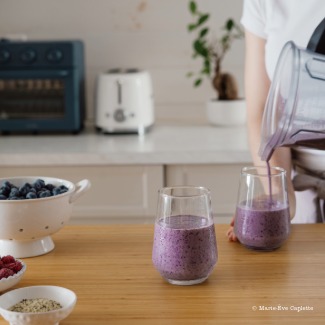Smoothies have a lot going for them. They’re quick to make, portable, and most importantly, can be a healthy part of your diet. All you need are the right ingredients. Whether you’re looking for an on-the-go breakfast, a satisfying snack, or a post workout energy boost, a nutritious smoothie can be a tasty way to stay full between meals. But watch out—for a smoothie to really keep you full and energized for hours, it needs to contain a few key food groups. Read on for tips on crafting a truly satisfying smoothie, plus some ideas for ingredients that maximize nutritional value.
The 4 Building Blocks of a Nutritious Smoothie
1. Carbohydrates for energy
Fruit is often a staple of smoothies, and with good reason! It’s naturally sweet and rich in fibre, vitamins, and antioxidants.
Examples:
• Fresh or frozen banana
• Strawberries, blueberries, or raspberries
• Dates, for natural sweetness
Tip: For a thicker smoothie, use frozen fruit.
2. Protein to keep you full
A source of protein is easy to forget, but it’s the one ingredient that makes all the difference when it comes to avoiding that 10 a.m. slump. Protein plays a key role in helping you feel full for longer, stabilizing your energy levels, and preventing midmorning hunger pangs.
Examples:
• Fortified plant milk (check the protein content)
3. Good fats for nutrient absorption and long-lasting energy
Adding good fats to your smoothie helps your body absorb vitamins A, D, E, and K. It also promotes slower digestion, helping you maintain more consistent energy levels and avoid blood sugar spikes and crashes.
Examples:
• Avocado
• Nuts
4. Fibre for digestion and satiety
Even though fibre isn’t directly digested or absorbed by the body, it’s an essential part of a healthy diet. It helps you feel fuller for longer and supports good digestion by promoting regular bowel movements and feeding the gut microbiome.
Examples:
• Frozen zucchini or cauliflower
• Grated carrots
Adjust to suit your needs
It can be tempting to make your smoothie feel like a dessert by loading it up with fruit, juice, and sweeteners such as maple syrup. Smoothies like that may taste great, but they don’t do much for you in the long run. If you want your smoothie to keep you full until your next meal, think about the recipe in terms of your protein, fat, and fibre needs.
The great thing about smoothies is that they’re versatile: You can easily adjust the recipe to suit your needs on a day-to-day basis. For instance, a smoothie made mostly of carbohydrates (e.g., fruit and almond milk) could be ideal as a pre workout snack, since it’s easy to digest.
In short, there’s no one right way to make a smoothie. It all depends on its role in your diet and your nutritional needs. As a general rule, including the key nutrients listed above will make for a filling and nutritious smoothie, every time.
Liquid versus solid food
Did you know that drinking a smoothie doesn’t give you the same feeling of fullness as you’d get from eating all the same ingredients whole? That’s because food consumed in liquid form is not chewed, takes less time to eat, and takes up less space in your stomach. If you’re finding that smoothies just don’t keep you full for very long, there are a few tricks you can try:
• Drink more slowly
• Add more fibre and protein
• Eat something solid as well, such as nuts or a homemade muffin
Conclusion
To make a truly nutritious smoothie, follow the same principles as for a balanced meal —just in liquid form! Here’s a simple recipe for a single-serving smoothie to get you started:
• 1 cup fruit
• 1 cup cow or plant milk
• ½ cup Greek yogurt
• 1 to 2 tablespoons nut butter or seeds
• ½ cup leafy greens
Blend everything together and add water, ice cubes, or a splash of plant milk until you’re happy with the texture.

